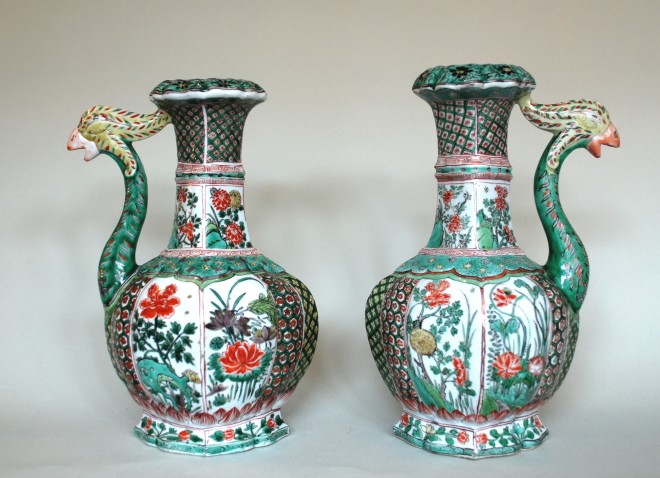BF30
Of octagonal section, the bulbous faceted body following a lozenge-form outline, rising from a barbed foot to a ridged neck and an inverted galleried mouth, delicately enameled to the exterior in the famille verte palette with panels of flowering branches issuing from rockwork and flying insects, the flowers representing the four seasons (prunus, peony, lotus and chrysanthemum), all above a basal frieze of lotus petals moulded in relief, the tall flaring neck with birds and vegetation, the slender tapering serpentine spout joined to the neck by a phoenix head in profile, the base glazed.
Literature
The kendi is a vessel whose origin probably derives from a ritual bronze or earthenware kundika, a Sanskrit term for 'water-pot' and an attribute of Brahma in Hindu iconography. While many forms of kendi are simple and utilitarian, a number are partially or entirely zoomorphic. The most common beasts used being the dragon, the chicken, duck, the frog, or the phoenix as in the present example. While the phoenix head has been used on ewers since the Tang dynasty, the form of this blue and white example is unknown before the early Qing dynasty and appears to have been a development of the late Shunzhi or early Kangxi period that is between about 1655 and 1683.
Ewers of this form were originally inspired by middle-eastern metal wares and were made for the export market There is a pair of famille verte ewers of similar form and decoration illustrated in Famille Verte: Chinese Porcelains in Green Enamels by Christiaan J. A. Jorg (2011, Groninger Museum, p.41, pl.30).These ewers were formerly in the estate of R. May and acquired by the state in 1944 before being transferred to the Rijksmuseum in 1947. See also C J A Jörg, Chinese Ceramics in the Collection of the Rijksmuseum, Amsterdam, p.162, no.177 where this pair of kendi are also illustrated.
There is a pair of similar form, also decorated in famille verte enamels in the Philadelphia Museum, attributed Kangxi (accession number 1955-50-161a,b, The Alfred and Margaret Caspary Memorial Gift, 1955). Also compare a closely related ewer from the Avery Brundage Collection, now at the Asian Art Museum, San Francisco (accession number B60P249). A pair from the Grandidier Collection, now at the Louvre Museum, was paired with three blue and white bottle vases to form an ad hoc garniture set and is illustrated in La Ceramique Chinoise: de L'Epoque de K'ang-hi a nos Jours, Paris, 1922, pl. 244.

